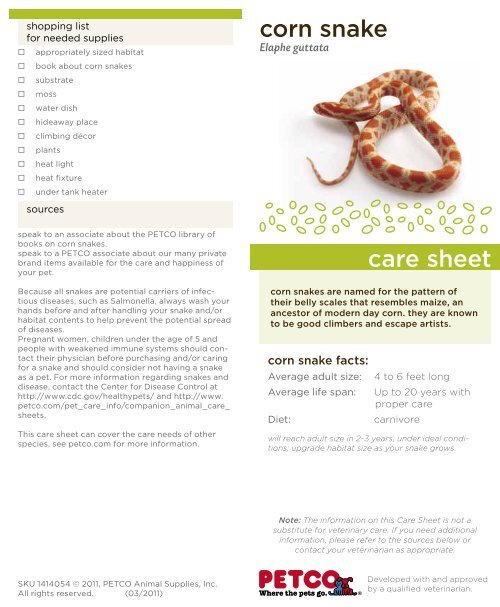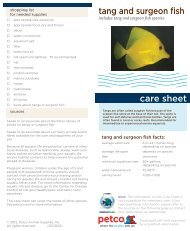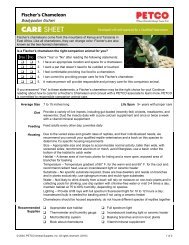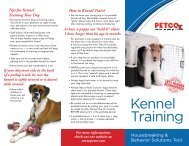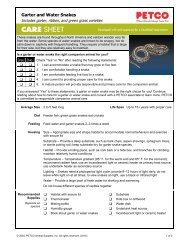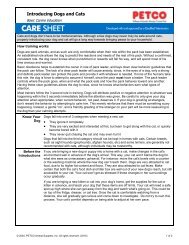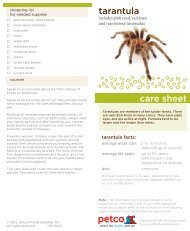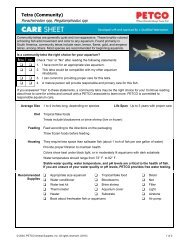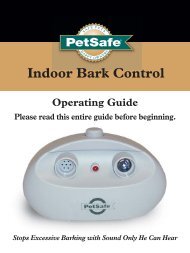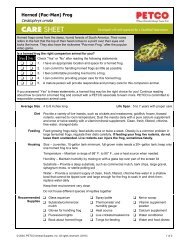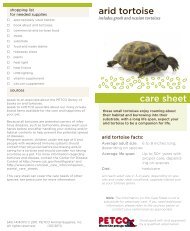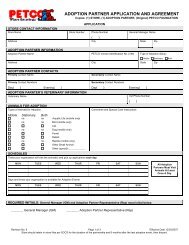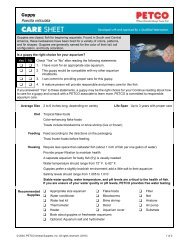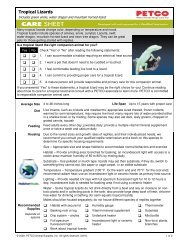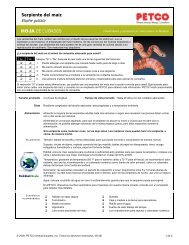corn snake care sheet - Petco
corn snake care sheet - Petco
corn snake care sheet - Petco
You also want an ePaper? Increase the reach of your titles
YUMPU automatically turns print PDFs into web optimized ePapers that Google loves.
shopping list<br />
for needed supplies<br />
<br />
appropriately sized habitat<br />
<br />
book about <strong>corn</strong> <strong>snake</strong>s<br />
<br />
substrate<br />
<br />
<br />
<br />
<br />
<br />
<br />
<br />
<br />
moss<br />
water dish<br />
hideaway place<br />
climbing décor<br />
plants<br />
heat light<br />
heat fixture<br />
under tank heater<br />
sources<br />
<strong>corn</strong> <strong>snake</strong><br />
Elaphe guttata<br />
speak to an associate about the PETCO library of<br />
books on <strong>corn</strong> <strong>snake</strong>s.<br />
speak to a PETCO associate about our many private<br />
brand items available for the <strong>care</strong> and happiness of<br />
your pet.<br />
Because all <strong>snake</strong>s are potential carriers of infectious<br />
diseases, such as Salmonella, always wash your<br />
hands before and after handling your <strong>snake</strong> and/or<br />
habitat contents to help prevent the potential spread<br />
of diseases.<br />
Pregnant women, children under the age of 5 and<br />
people with weakened immune systems should contact<br />
their physician before purchasing and/or caring<br />
for a <strong>snake</strong> and should consider not having a <strong>snake</strong><br />
as a pet. For more information regarding <strong>snake</strong>s and<br />
disease, contact the Center for Disease Control at<br />
http://www.cdc.gov/healthypets/ and http://www.<br />
petco.com/pet_<strong>care</strong>_info/companion_animal_<strong>care</strong>_<br />
<strong>sheet</strong>s.<br />
This <strong>care</strong> <strong>sheet</strong> can cover the <strong>care</strong> needs of other<br />
species, see petco.com for more information.<br />
<strong>care</strong> <strong>sheet</strong><br />
<strong>corn</strong> <strong>snake</strong>s are named for the pattern of<br />
their belly scales that resembles maize, an<br />
ancestor of modern day <strong>corn</strong>. they are known<br />
to be good climbers and escape artists.<br />
<strong>corn</strong> <strong>snake</strong> facts:<br />
Average adult size: 4 to 6 feet long<br />
Average life span: Up to 20 years with<br />
proper <strong>care</strong><br />
Diet:<br />
carnivore<br />
will reach adult size in 2-3 years, under ideal conditions;<br />
upgrade habitat size as your <strong>snake</strong> grows.<br />
Note: The information on this Care Sheet is not a<br />
substitute for veterinary <strong>care</strong>. If you need additional<br />
information, please refer to the sources below or<br />
contact your veterinarian as appropriate.<br />
SKU 1414054 © 2011, PETCO Animal Supplies, Inc.<br />
All rights reserved. (03/2011)<br />
Developed with and approved<br />
by a qualified veterinarian.
<strong>care</strong> <strong>sheet</strong><br />
<strong>corn</strong> <strong>snake</strong><br />
Elaphe guttata<br />
Developed with and approved<br />
by a qualified veterinarian.<br />
diet<br />
a well-balanced <strong>corn</strong><br />
<strong>snake</strong> diet consists of:<br />
• appropriate size<br />
frozen rodents,<br />
thawed/warmed<br />
to above room<br />
temperature. if<br />
feeding your <strong>snake</strong><br />
live rodents, do<br />
not leave them<br />
unattended. live<br />
rodents can injure<br />
the <strong>snake</strong>, sometimes<br />
fatally.<br />
feeding<br />
things to remember<br />
when feeding your <strong>corn</strong><br />
<strong>snake</strong>:<br />
• feed juveniles once or<br />
twice a week, adults<br />
every one to two<br />
weeks.<br />
• feed in a separate tank<br />
so that your <strong>snake</strong><br />
doesn’t associate your<br />
hand or the habitat<br />
being opened with<br />
feeding.<br />
housing<br />
• size - appropriate size<br />
and shape habitat for<br />
an adult colubrid to<br />
accommodate normal<br />
behavior and exercise,<br />
at least a 40 breeder.<br />
• substrate - aspen<br />
shavings, mulch-type<br />
such as coconut fiber<br />
bedding or reptile<br />
bark; dampened<br />
sphagnum moss. avoid<br />
gravel and artificial<br />
turf (too harsh for<br />
skin).<br />
• habitat - provide a<br />
hiding area just large<br />
enough for your <strong>snake</strong><br />
to fit inside and a<br />
branch or decor to<br />
climb on. maintain 40-<br />
60% humidity; higher<br />
during shedding.<br />
• temperature -<br />
temperature gradient<br />
(85°F for the warm<br />
end and 70° for the<br />
cool end); recommend<br />
radiant heat; use an<br />
incandescent light as<br />
primary heat source,<br />
use under tank heater<br />
as secondary source.<br />
• lighting - <strong>snake</strong>s need<br />
a photoperiod light<br />
cycle; provide 8-12<br />
hours of light daily.<br />
don’t leave white light<br />
on at all times; a black<br />
or infrared light should<br />
be used at night.<br />
• adult <strong>corn</strong> <strong>snake</strong>s can<br />
be housed together<br />
but do not house<br />
different <strong>snake</strong><br />
species together.<br />
normal<br />
behavior<br />
as <strong>snake</strong> gets ready to<br />
shed, eyes will turn a<br />
milky blue/grey over the<br />
course of a few days and<br />
body color will start to<br />
dull and develop a whitish<br />
sheen. may become<br />
irritable, avoid handling.<br />
appetite may vary<br />
habitat<br />
maintenance<br />
thoroughly clean the<br />
habitat at least once a<br />
week: place <strong>snake</strong> in a<br />
secure habitat; scrub<br />
the tank and furnishings<br />
with a 3% bleach solution;<br />
rinse thoroughly<br />
with water, removing all<br />
traces of bleach smell;<br />
dry the tank and furnishings<br />
completely and add<br />
clean substrate.<br />
grooming<br />
& hygiene<br />
<strong>snake</strong>s will regularly<br />
shed their skin; ensure<br />
humidity of habitat is<br />
at appropriate level to<br />
allow <strong>snake</strong> to shed<br />
properly.<br />
signs of a<br />
healthy animal<br />
• active and alert<br />
• clear eyes (except<br />
when shedding)<br />
• eats regularly<br />
• healthy skin<br />
• sheds regularly<br />
• sheds skin in one<br />
complete piece<br />
red flags<br />
• unusually frequent<br />
or infrequent<br />
shedding<br />
• vomiting<br />
• lethargic or reluctant<br />
to eat<br />
• abnormal feces<br />
• bumps or spots on<br />
skin<br />
• labored breathing<br />
• difficulty shedding<br />
• white, cheesy<br />
substance in mouth<br />
If you notice any of these signs, please contact your<br />
exotic animal veterinarian.<br />
common health issues<br />
Health Issue Symptoms or Causes Suggested Action<br />
dermatitis<br />
respiratory<br />
disease<br />
stomatitis<br />
ticks and mites<br />
blisters, rapid shedding consult your exotic<br />
caused by an unclean habitat animal veterinarian,<br />
or one that is too cold or clean the habitat and<br />
damp.<br />
lower humidity.<br />
labored breathing, mucus<br />
in mouth or nostrils. can be<br />
caused by a habitat that is<br />
too cold or damp.<br />
white, cheesy substance in<br />
the mouth, loss of teeth and<br />
appetite. if untreated, can<br />
be fatal.<br />
parasites on skin, can<br />
transmit disease.<br />
consult your exotic<br />
animal veterinarian<br />
and keep <strong>snake</strong> warm<br />
and dry.<br />
immediately consult<br />
your exotic animal<br />
veterinarian.<br />
consult your exotic<br />
animal veterinarian.


